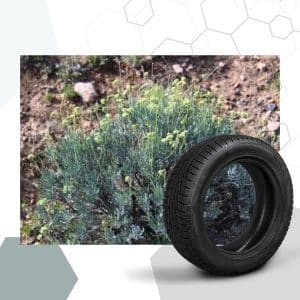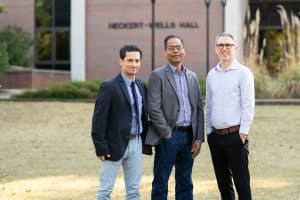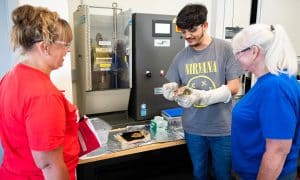In the 1850s, the area around Pittsburg, Kansas, where Kansas meets Oklahoma and Missouri, was mined for tremendous amounts of lead and zinc. Mining continued until the 1970s; since then, the region’s farming, mining, and industrial communities have struggled to adapt to vast economic shifts. Now they also face changing rainfall patterns. These challenges—land contaminated with heavy metals and other remnants of the mining industry, job losses and population decline, and now water scarcity—are tough when considered individually. But collectively, they can seem insurmountable.
Still, the region has unique strengths, including that it remains a crossroads for several rail lines. I’ve also found the people of the area have a deep interest in economic revitalization. After a career in materials science, I came to Pittsburg State University (PSU) about a decade ago, impressed by the school’s polymers research center and its potential to create new industries. As executive director for the advancement of applied science and technology at PSU’s National Institute for Materials Advancement (NIMA), I want to help the area reinvent itself.
One way we’re trying to do this is by bringing farmers and scientists together. In February 2020, PSU convened a workshop of 70 local farmers and ranchers, along with NIMA and partners from Virginia Tech’s Macromolecules Innovation Institute, to discuss the challenges farmers face. The meeting was facilitated by extension agents from Kansas State University, who also acted as interpreters between the farmers and scientists.
The farmers told us about their concerns, which included plastic waste and the problem of cattle ingesting the plastic netting used to bind hay, as well as the effects of climate change on local crops such as sorghum and wheat. They also spoke about the difficulty of finding markets for these crops as global prices fluctuate. And on a more personal note, they shared their frustrations as their children left the area to find good jobs elsewhere, leaving behind family farms.
Today most natural rubber is imported, and guayule has been proposed as a possible way to shore up supply chains by producing more rubber in the United States.
After the workshop, researchers and extension agents spent a half day talking about how materials science might be brought to bear in resolving some of the farmers’ concerns. I was excited by the farmers’ engagement and intrigued by the juxtaposition of PSU’s cutting-edge research capacity and the assembled vast agricultural knowledge standing in stark contrast to the region’s struggling economy. When I recapped the event with Paul Hughes, Kansas’s then deputy secretary of commerce, we started talking about potential drought-tolerant crops for semiarid areas. He asked if I had considered the guayule plant; I had not.
The guayule plant is a shrub native to the southwestern United States and northern Mexico that produces high-quality latex comparable to that of the traditional rubber tree. Today most natural rubber is imported, and guayule has been proposed as a possible way to shore up supply chains by producing more rubber in the United States. From my perspective, combining drought-resistant guayule with southeast Kansas’s agricultural expertise, vast land, and polymer know-how connected all the dots.
At NIMA we began to talk about the possibility of leveraging our polymer chemistry and plastics processing expertise to build a farm-to-factory process for creating natural rubber. The entire rubber value chain, from cultivation to manufacturing, could create a diverse range of jobs while providing farmers a cash crop with innate drought tolerance. What’s important here is the marriage of agriculture with manufacturing: We imagined a regional bio-based materials manufacturing hub that could transform our struggling rural communities in the “middle of nowhere” into bustling towns “at the center of everything.”
Of course, we are one of hundreds of communities in the United States dreaming of combining local skills and strengths with new technologies to foster regional development. When the National Science Foundation (NSF) put out a call to join the Regional Innovation Engines program, the agency received 679 applications. (PSU was a partner on two of those applications.) Hundreds of communities have applied to similar programs from the Department of Commerce, the Department of Energy (DOE), and the Department of Defense (DOD). Across the nation, there is terrific interest in following paths like this, but there are few coordinated roadmaps to help us get on that highway. Pittsburg is a town of just 20,600 people with a small but feisty state university. Realizing our ambitions requires not only knowledge and innovation and croplands and startups, but also ways to connect to the work that has already been done and do the work that needs to be done—all while coordinating with other places on a similar path.
The rubber conundrum
Although the United States uses vastly more synthetic rubber than natural, it still imports more than $2 billion of natural rubber per year, sourced mostly from rubber trees in Indonesia and Thailand. Natural rubber is particularly important for heavy-duty tires and uses that require durability, including conveyor belts, power transmission belts, seals, gaskets, and O-rings. Natural rubber supply chains were disrupted even before demand for surgical gloves exploded during the pandemic—which brought the trade to what has been described as “the cusp of a rubber apocalypse.” Adding to worries about the geographic concentration of today’s rubber supply, the South American leaf blight, a fungal disease, poses significant risks to the long-term viability of natural rubber production.
Over the past decade, there has been a growing awareness that the United States needs a more secure domestic source of natural rubber. Creating a domestic supply has also been discussed as a chance to develop sources that use more sustainable agricultural and manufacturing processes.
Recently, NSF established an Engineering Research Center to work on fundamental research for US natural rubber manufacturing. The $26 million investment is intended to work toward a “circular biomanufacturing economy that respects natural systems, including pollinator services by the new domestic crops, water recycling and reuse, additional CO2 capture, and an estimated 2 million jobs tied to US soil.”
We are one of hundreds of communities in the United States dreaming of combining local skills and strengths with new technologies to foster regional development.
Although there are many plants that could produce latex domestically, including rabbitbrush, Russian dandelion, milkweed, and mountain gum, guayule has emerged as a good candidate for arid climates. The tire manufacturing company Bridgestone and the University of Arizona have a joint project on guayule research and development. In collaboration with Bridgestone, biotech company PanAridus has been using selective breeding to improve the amount of rubber the crop yields per acre for more than a decade. And recent research from Ohio State University has pioneered new processes to extract more rubber once plants are harvested.
However, bridging the gap between promising research and building a thriving industry will require a concerted approach, including ample support and collaboration among academic researchers, industry, and local and federal government. Once funding has been found to develop the industry, it will be necessary to cultivate a domestic market for biobased rubber—and let’s not forget standards and regulations. As I started to explore how Pittsburg might start working with guayule and other natural rubber, I realized that lots of promising pieces are floating around, but it’s not clear how we can raft them all together to collaborate.
Where to start?
The most basic practical concern in considering guayule as a Kansas and Oklahoma crop is cold tolerance. I made a couple of phone calls to researchers at the US Department of Agriculture (USDA), who reassured me there are likely strains that would be promising candidates, and that if those didn’t work, some of the alternative plants might. Understanding the climatic suitability of the crop will be essential in considering how it may fare now and as the climate changes, which will require ongoing research and adaptation strategies.
Introducing these drought-tolerant rubber crops could provide farmers with an alternative source of income from local markets. In informal conversations with local farmers, they are quick to support the idea, suggesting both challenges and benefits—including the opportunity to broaden their crop rotations. And, in the meantime, one of the extension agents involved in the initial conversations with farmers has been elected to the Kansas legislature.
I then attempted to contact the companies that are exploring guayule, with varying success. I reached out to the NSF Engineering Research Center working on biorubber and will be talking with them soon. Along with NIMA, Kansas State University is also a member of BioMADE, a manufacturing innovation institute sponsored by the DOD, but I haven’t found a defined entry point into biorubber research there either. The USDA, NSF, DOD, and DOE all have initiatives devoted to the development of biorubber. Each one offers a good starting point, but strategic adjustments are needed to make them truly effective. It would be a big help if the National Biotechnology and Biomanufacturing Initiative or other crosscutting projects offered some way for small centers like mine to navigate these disparate projects.
If these agencies and industry research centers made a call to action around biorubber, we would be excited to join. More importantly, if there were a coordinated strategy among them, we could determine where we could participate and how we might pool local and regional resources. Importantly—and this often gets overlooked—we might also quickly learn that guayule research is not for us, or not for us right now. And that would enable us to move on to hunt for new projects for local development.
In the meantime, the Pittsburg area has readied itself for whatever opportunities come along. In 2022, PSU’s Tyler Research Center, which hosts NIMA, received a $3 million federal grant to build a “prove-out center” to commercialize new materials that have the potential to reshore jobs that have gone overseas. Kansas senator Jerry Moran, who sits on the Senate Appropriations Subcommittee for Commerce, Justice, Science, and Related Agencies, articulated the ambition: “I have a dream for my state … I recognize that while we have lots of attributes in our economy, lots of pillars, how good it would be if we could add science, mathematics, engineering, and research to that component. So we have in place not only students who are learning here, but economic activities that create jobs and opportunities for people to pursue their dreams in Kansas. This is one more step.” The facility has continued to gather regional and national support and now has $8 million in funding. Subsequently Senator Moran visited NIMA again, bringing along NSF director Sethuraman Panchanathan and the state’s lieutenant governor to see Pittsburg’s potential role in spurring a resurgence of innovation and jobs in the heartland.
From where I sit, the potential is obvious. For nearly three years, NIMA has been working with the Defense Innovation OnRamp Hub to host Encountering Innovations, a Shark Tank–like forum where inventors from multiple states show their working prototypes to technology scouts. In 2023, we drew dozens of inventors to meet with a distinguished group of speakers and tech scouts from industry, academia, the DOD, and the state of Kansas.
The transformation of the heartland’s economy will require similar deliberate coordination across multiple states. It will need funding, of course, but also streamlined application processes so that more small centers and communities can join. To get a start on critical materials like biorubber, policymakers should prioritize strategic coordination, ask agencies to issue a call to action, encourage public-private partnerships, and speed the creation of pilot projects to create and share knowledge widely.
Communities like mine are at a pivotal moment. We have been through some rough decades, but we see the potential for rebirth in recent federal investments in science, in new technologies on the horizon, and in the opportunities presented by onshoring and ecologically sustainable technologies. Among local people and governments there is tremendous enthusiasm to build something new. Projects such as biorubber offer a vision that by working together, we can prevent a crisis—a “rubber apocalypse”—while also rebuilding our communities through jobs. But all of this energy and excitement needs leadership, coordination, and a strategy big enough to include everyone.




